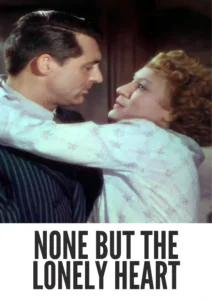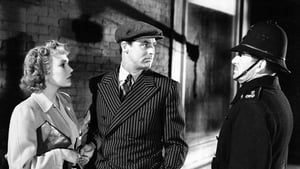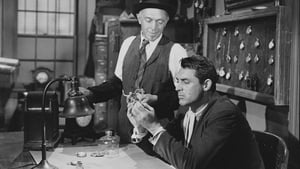Contact: info@alwanfilm.com
Video Sources 0 Views
- Watch trailer
- None But the Lonely Heart


Synopsis
Table of Contents
ToggleReview: None But the Lonely Heart 1944 Colorized – A Poignant Portrait of Love and Despair

Introduction
None But the Lonely Heart, released in 1944, is a poignant drama directed by Clifford Odets, based on the novel by Richard Llewellyn. Renowned for its heartfelt performances and emotional depth, this classic film explores the complexities of love, family, and personal sacrifice in the midst of adversity. In this review, we’ll delve into the tender beauty of None But the Lonely Heart and its enduring legacy in the world of cinema.
Check The Full Colorized Movies List
Check Our Colorized Movies Trailer Channel
Understanding None But the Lonely Heart 1944 Colorized: Director, Cast, and Genre
Directed by Clifford Odets, None But the Lonely Heart features a stellar cast led by Cary Grant, Ethel Barrymore, and Barry Fitzgerald. The film belongs to the drama genre, known for its exploration of human emotions and relationships with depth and sensitivity.
Exploring the World of None But the Lonely Heart 1944 Colorized: Plot and Characters
None But the Lonely Heart tells the story of Ernie Mott, a troubled young man who returns to his working-class neighborhood in London to care for his ailing mother, Ma Mott. As Ernie struggles to make ends meet and resist the allure of a life of crime, he forms a deep bond with his mother and finds solace in the arms of his childhood sweetheart, Ada. However, as Ernie becomes increasingly entangled in the criminal underworld, he must confront the harsh realities of poverty, love, and personal responsibility.
The Art of Film Colorization
While None But the Lonely Heart was originally filmed in black and white, its early colorized version adds a new layer of emotional depth to its poignant narrative. The colorization process enhances the film’s evocative cinematography and captures the nuances of its characters’ emotions with striking clarity.
Early Colored Films: A Brief History
The history of early colored films is marked by innovation and experimentation as filmmakers sought to enhance the visual appeal of their movies. From hand-tinted frames to pioneering technicolor processes, the evolution of colorization techniques transformed the cinematic landscape, offering audiences a new way to experience the emotional intensity of dramatic storytelling.
None But the Lonely Heart (1944) and Its Early Colored Version
The decision to release None But the Lonely Heart in a colorized format was made with the intention of immersing audiences in the emotional richness of its heartfelt narrative and enhancing the film’s visual impact. While some purists may prefer the original black and white version, the early colorized edition of None But the Lonely Heart adds a new layer of depth to its evocative cinematography and captures the emotional complexity of its characters with breathtaking clarity.
The Debate Over Film Colorization
The debate over film colorization continues to divide audiences and industry professionals alike. While some argue that colorization breathes new life into classic films and makes them more accessible to modern audiences, others maintain that it compromises the artistic integrity of the original work. As technology advances and filmmaking techniques evolve, the debate over colorization remains a topic of ongoing discussion within the film community.
Examining None But the Lonely Heart (1944) as an Early Colored Film
Viewing None But the Lonely Heart in its early colorized iteration offers audiences a fresh perspective on its emotional depth and heartfelt performances. The colorization process enhances the film’s evocative cinematography and captures the nuances of its characters’ emotions with stunning clarity. As viewers are drawn into the tender and intimate world of Ernie Mott and his loved ones, they are treated to a visual feast that immerses them in the bittersweet beauty of human relationships.
Influence and Legacy: None But the Lonely Heart 1944 Colorized’s Impact on Cinema
None But the Lonely Heart is widely regarded as a masterpiece of the drama genre that continues to resonate with audiences for its heartfelt performances and emotional resonance. Its exploration of themes such as love, family, and personal sacrifice has left an indelible mark on cinema, inspiring filmmakers and touching the hearts of viewers around the world.
Director’s Cinematic Legacy: Beyond None But the Lonely Heart 1944 Colorized
Clifford Odets’s directorial legacy extends far beyond None But the Lonely Heart, encompassing a diverse body of work that includes acclaimed films such as The Country Girl and The Big Knife. As one of the most respected filmmakers of his generation, Odets was known for his ability to craft emotionally resonant stories that explored the complexities of the human experience with depth and sensitivity. None But the Lonely Heart stands as a testament to his talent and creativity, solidifying his reputation as one of the great auteurs of classic Hollywood cinema.
Themes Explored in None But the Lonely Heart 1944 Colorized
At its core, None But the Lonely Heart explores themes of love, family, and personal sacrifice in the face of adversity. Through its heartfelt performances and poignant narrative, the film offers a moving portrayal of the human condition, challenging viewers to confront their own beliefs about love, responsibility, and the bonds that unite us.
Reception and Controversy Surrounding None But the Lonely Heart 1944 Colorized
Upon its release, None But the Lonely Heart received widespread critical acclaim for its heartfelt performances, emotional depth, and evocative cinematography. While the decision to release the film in a colorized format sparked debate among purists, its enduring popularity has cemented its status as a timeless classic of the drama genre.
Where to Watch None But the Lonely Heart 1944 Colorized Online
For those eager to experience None But the Lonely Heart for themselves, the film is readily available on popular streaming platforms such as Amazon Prime Video, Google Play Movies, and iTunes. Whether viewed in its original black and white format or its early colorized iteration, None But the Lonely Heart offers a cinematic experience that is both heartfelt and visually stunning.
FAQs About None But the Lonely Heart 1944 Colorized
1. Is None But the Lonely Heart based on a true story?
No, None But the Lonely Heart is a fictional film based on the novel by Richard Llewellyn. While the story may draw inspiration from real-life events, its characters and plot are works of fiction.
2. Who starred in None But the Lonely Heart?
None But the Lonely Heart stars Cary Grant in the role of Ernie Mott, a troubled young man who returns to his working-class neighborhood in London to care for his ailing mother, Ma Mott. He is supported by Ethel Barrymore, who delivers a memorable performance as Ma Mott, and Barry Fitzgerald as Jim Mordinoy, a kindly pawnbroker who becomes a father figure to Ernie.
3. What is the central message of None But the Lonely Heart?
At its core, None But the Lonely Heart explores the enduring power of love and family in the face of adversity. Through its heartfelt performances and poignant narrative, the film offers a moving portrayal of the human condition, challenging viewers to confront their own beliefs about love, responsibility, and the bonds that unite us.
4. Why was None But the Lonely Heart released in a colorized format?
The decision to release None But the Lonely Heart in a colorized format was made with the intention of immersing audiences in the emotional richness of its heartfelt narrative and enhancing the film’s visual impact. While some purists may prefer the original black and white version, the early colorized edition of None But the Lonely Heart adds a new layer of depth to its evocative cinematography and captures the emotional complexity of its characters with breathtaking clarity.
5. What is the legacy of None But the Lonely Heart?
None But the Lonely Heart is widely regarded as a masterpiece of the drama genre that continues to resonate with audiences for its heartfelt performances and emotional resonance. Its exploration of themes such as love, family, and personal sacrifice has left an indelible mark on cinema, inspiring filmmakers and touching the hearts of viewers around the world.
6. Are there any sequels or remakes of None But the Lonely Heart?
No, there have been no official sequels or remakes of None But the Lonely Heart. However, the film’s enduring popularity has inspired countless reinterpretations and homages in various media. Nonetheless, none have captured the heartfelt performances and emotional depth of the original 1944 classic.
7. Where can I watch None But the Lonely Heart online?
For those eager to experience None But the Lonely Heart for themselves, the film is readily available on popular streaming platforms such as Amazon Prime Video, Google Play Movies, and iTunes. Whether viewed in its original black and white format or its early colorized iteration, None But the Lonely Heart offers a cinematic experience that is both heartfelt and visually stunning.
Conclusion
In conclusion, None But the Lonely Heart (1944) stands as a timeless classic of the drama genre that continues to captivate audiences with its heartfelt performances, emotional depth, and evocative cinematography. Whether viewed in its original black and white format or its early colorized iteration, Clifford Odets’s insightful direction and the stellar performances of the cast offer a cinematic experience that is both tender and visually stunning.
As viewers are drawn into the intimate world of Ernie Mott and his loved ones, they are treated to a moving journey that celebrates the enduring power of love, family, and personal sacrifice. None But the Lonely Heart remains a poignant portrait of love and despair that continues to touch the hearts of viewers around the world.













